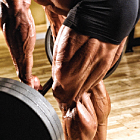 Most of us train more than one muscle group in a workout, unless we train seven days a week and only do one bodypart a day (something I don’t feel is smart for most people due to accumulated central nervous system fatigue). Does it matter which you train first?
Most of us train more than one muscle group in a workout, unless we train seven days a week and only do one bodypart a day (something I don’t feel is smart for most people due to accumulated central nervous system fatigue). Does it matter which you train first?
In the case of arms, the gym wisdom was to train triceps first. The reasoning was that a pumped biceps would prevent a full range of motion in triceps movements; that is, you wouldn’t be able to get a complete triceps stretch due to the obstruction of the biceps. In reality, that’s only true if you have long biceps that attach at or close to your elbow joints, and even then only if they are extremely large.
The fact is, you can train biceps or triceps first on arm day, but I much prefer alternating exercises for each. You can do it either by completing all work sets for a biceps exercise and then doing all sets for a triceps movement or supersetting for three to four rounds of something like barbell curls and skull crushers or cable curls and cable pushdowns.
There are some rules to follow regarding the order of bodyparts you train in a given workout. You never want to work a smaller muscle first that will be assisting a larger muscle afterward, as in doing triceps before chest or shoulders or biceps before back. The smaller arm muscles are already a weak link in the chain in the compound movements, and training them first will only sabotage the effectiveness of your workout for the larger group. I believe in not training the smaller muscles even the day before, as they won’t recover fully in time to do a good job assisting the larger one.
That also applies to working shoulders before chest in the same workout, something few people do anyway. I happen to do it a lot, but only because my chest is close to being as big as it will ever need to be, while a guy with fairly wide hips like mine can never have shoulders that are too big and round. Hitting shoulders on the day before your chest workout isn’t a great idea for the same reason, and you shouldn’t train triceps on the day before you work chest or shoulders.
I believe that most people should train hamstrings before quads on leg day. It hardly ever seems to take away from what you do for quads, but rare is the man or woman who can run through a heavy and intense quad workout of, say, squats, leg extensions, leg presses, hack squats and lunges and then do proper justice to his or her hams. In fact, that’s the reason that most people’s hamstring development lags far behind their quads. By the time they get to hams, they’re usually pretty exhausted and don’t have enough gas in the tank to give the hamstrings the hard work they need to grow.
After the order of bodyparts comes the arrangement of exercises within a bodypart workout. Unless you’re older and/or dealing with injuries and chronic issues like arthritis and tendinitis, you should do your free-weight compound movements early in the session. The free-weight basics like bench press, squat, military press and deadlift all require a lot of balance and coordination, qualities that diminish rapidly as your workout progresses. I noticed that many years ago. Say it was chest day. If I did incline dumbbell presses, I could work up to good sets with anywhere from 120s to 140s, but if I did a Hammer Strength machine or two first instead, I would struggle with 90s! It wasn’t that my pressing strength was down that much. I simply couldn’t balance heavy dumbbells unless I was fresh. Some people can still squat fairly heavy even after doing other quad movements, but dumbbells seem to be tough for anyone if they’re used too far into the workout.
Again, there are exceptions. Someone whose shoulders and triceps tend to take over on any type of chest press would be wise to do at least one flye movement beforehand (for example, dumbbell flyes or pec deck) to preexhaust the pectorals. If your form on squats is good yet you still tend to feel your glutes and lower back working more than your quads, go ahead and hit leg extensions hard for a few sets first, even doing techniques like drop sets and rest/pause for extra fatigue. That will cut down on the weight you use for squats, but squatting more weight means jack if your butt and back are doing all the work. It’s also beneficial to preexhaust the quads with extensions if you have issues with your lower back and/or knees that make heavier squats a risky venture for you.
Generally speaking, it’s a good idea to base your order of exercises on how relatively easy or difficult they are in terms of balance and coordination, as follows: dumbbells, barbells and then machines and cables. In upper-body workouts the larger muscle groups—the torso groups— should be trained before the upper-arm muscles.
These are just general guidelines, but you should find them helpful.
—Ron Harris
Editor’s note: Ron Harris is the author of Real Bodybuilding—Muscle Truth From 25 Years in the Trenches, available at www.RonHarrisMuscle.com.




















You must be logged in to post a comment Login